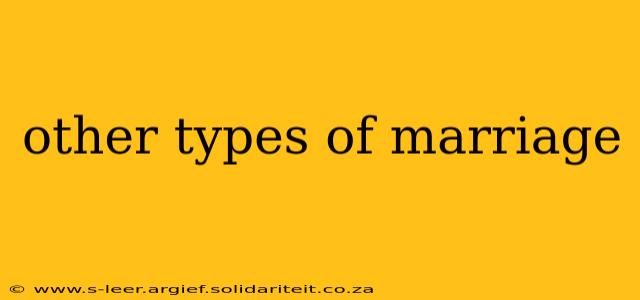The traditional image of marriage—a lifelong commitment between a man and a woman—is evolving. While this remains the most common form of marriage in many parts of the world, diverse cultural practices and changing social norms have led to the emergence of several other types of marriage. Understanding these different forms provides valuable insight into the complexities of human relationships and the multifaceted nature of commitment.
What are the different types of marriage?
This isn't an exhaustive list, as the specifics of marriage vary widely across cultures and historical periods, but it covers some of the most prominent alternatives to traditional monogamous marriage:
Polygamy:
This umbrella term encompasses marriages involving more than two people. It's further divided into:
- Polygyny: One man married to multiple women. This is the most common form of polygamy historically and remains practiced in some cultures today.
- Polyandry: One woman married to multiple men. This is less common than polygyny, often found in societies with scarce resources or unique inheritance practices.
It's crucial to note that the ethical and legal implications of polygamy vary drastically across different jurisdictions. In many Western countries, it's illegal. However, in other parts of the world, it's legally recognized and socially accepted.
Polyamory:
Unlike polygamy, which often involves a hierarchical structure, polyamory is characterized by consensual, transparent, and ethical relationships among multiple partners. All partners are typically aware of and agree to the relationships with the other partners. It emphasizes communication, honesty, and emotional intimacy above all else.
Polyamory is distinct from polygamy because it's generally not about legal marriage but about committed, loving relationships involving more than two people.
Open Marriage:
An open marriage is where partners agree to have sexual relationships with other people outside of the primary relationship. However, the core emotional and social commitment remains within the primary relationship. The level of openness and the rules surrounding it vary significantly depending on the couple's agreement. This type differs from polyamory in that it doesn't usually imply an emotional bond with other partners, focusing primarily on sexual exploration.
Same-Sex Marriage:
Legal recognition of same-sex marriage has expanded dramatically in recent decades. It signifies a significant shift in societal attitudes towards marriage and reflects a growing acceptance of LGBTQ+ relationships. The legal rights and social acceptance of same-sex marriage differ globally.
Common-Law Marriage:
Also known as informal marriage, this type of marriage doesn't involve a formal ceremony or legal registration. It’s recognized in some jurisdictions based on the couple presenting themselves as married, sharing assets, and living together for a specified period. The requirements for establishing common-law marriage vary considerably depending on the location.
How are these types of marriage different from traditional marriage?
The primary difference lies in the number of partners involved and the nature of the commitment. Traditional marriage typically involves two people in a monogamous relationship with a strong emphasis on exclusivity and lifelong commitment. Other types of marriage challenge these traditional norms, emphasizing diverse forms of love, intimacy, and commitment.
What are the legal implications of different types of marriage?
The legal recognition and consequences of different types of marriage vary widely depending on the jurisdiction. Polygamy is illegal in many countries, while same-sex marriage is legally recognized in a growing number. The legal implications regarding inheritance, taxes, and other rights often differ significantly for non-traditional marriage structures.
Is there a "best" type of marriage?
There's no single "best" type of marriage. The ideal type of marriage depends entirely on the individuals involved, their values, and their desires for a relationship. The crucial element in any successful marriage is mutual respect, open communication, and a shared commitment to the relationship's well-being, regardless of its form.
This exploration of different marriage types isn't intended to endorse or condemn any particular form. Instead, it aims to broaden understanding and encourage respectful dialogue about the evolving landscape of human relationships.
